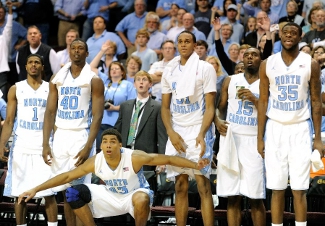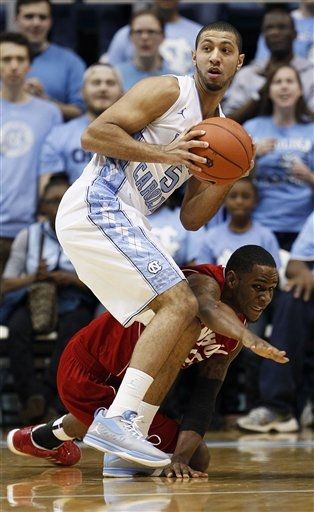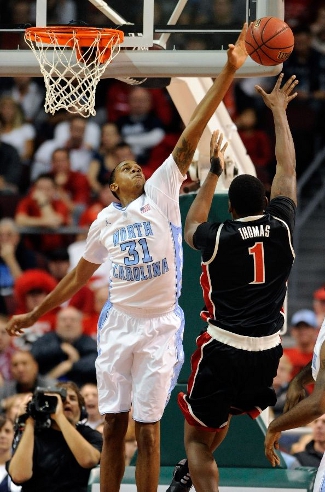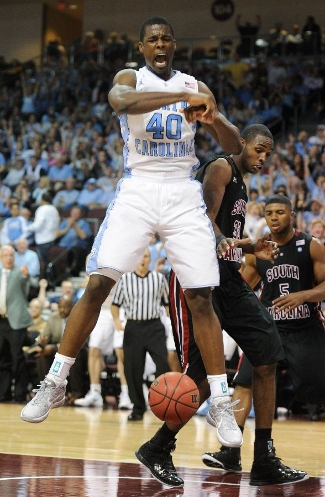Dean E. Smith Center | Chapel Hill, NC | Tip: 6:00 P.M. CT | TV: ESPN2 LRT Consecutive Game #198 On April 6th, John Henson and Tyler Zeller announced their intentions to return and chase a national championship at North Carolina. It was just the first in a series of announcements by high-profile players, all surefire NBA picks, who were spurning the allure of the League for another year as Big Man on Campus. Jared Sullinger of Ohio State and Perry Jones III of Baylor also elected to return to school, while Kentucky’s Terrence Jones withdrew his name after testing the waters. And then, just less than two weeks after Henson and Zeller made their joint announcement, Harrison Barnes made the Tar Heels the prohibitive preseason No. 1 when he passed on the NBA and returned to Chapel Hill. Texas had their own trio of stars mulling their draft fate, but with the wave of big-name players returning elsewhere, Longhorn fans had reason to be optimistic. If Jordan Hamilton, Tristan Thompson, and Cory Joseph made the same three-man pact that Barnes, Zeller, and Henson had made, there was no doubt that tonight’s match-up between the two teams would be a titanic clash of teams in the Top 10.
The Tar Heels have their sights set high this year It was not to be. Instead, the Longhorns enter tonight’s game at Chapel Hill with a young, rebuilding squad. Texas is unranked as they head into the Dean E. Smith Center, a place where the Tar Heels have knocked off the last 71 unranked non-conference opponents they’ve faced. Although the Longhorns have won the last four meetings between these two schools — a streak dating back to 1995 — the odds of that success continuing tonight are very, very slim. By the numbers The Tar Heels are an imposing bunch, not just in person, but also on paper. Their offense is seventh-best in the country when measured by adjusted efficiency, putting in 1.155 points each time down the floor. Lest opponents think they can simply get into a shootout with the Tar Heels, it must also be noted that the defense is nearly top-ten caliber, as well. The UNC defense is 11th-best in the country in adjusted defensive efficiency, allowing just 0.872 points per possession. The Tar Heels love to get out and run, playing at an adjusted tempo that is currently third-fastest in the nation. UNC averages 74.5 possessions per game, and the team has played two games this season with more than 85 possessions. The Longhorns have proven that they will engage in a track meet against other up-tempo squads, so the points should come quickly and often in tonight’s contest. Although North Carolina runs at a high pace, the team takes excellent care of the basketball. The Tar Heels are 14th in the country in turnover percentage, giving it up on just 16.7% of their possessions. In addition to valuing the ball, the Tar Heels also extend possessions with an offensive rebounding mark of 38.8%, a percentage that ranks in the top 30 of D-I hoops. On defense, North Carolina’s imposing front line makes it incredibly difficult to score. Henson and Zeller block and alter numerous shots from the Tar Heel opponents, but most importantly they do it without fouling. UNC has the best defensive free-throw rate in the nation, allowing less than one free throw for every five opponent field goals.
Kendall Marshall is always looking to pass The only one of Dean Oliver’s Four Factors that the Tar Heels don’t excel in is their defensive turnover percentage. North Carolina is one of the worst 100 teams in D-I hoops when it comes to forcing opponent miscues, a stat that makes their up-tempo success even more impressive. The Tar Heels simply run the floor better than their opponents, and are always looking to immediately move the ball up the court after both makes and misses. Meet the Tar Heels A big reason why that North Carolina transition game is so effective is lefty point guard Kendall Marshall (No. 5). When Texas faced the Heels in Greensboro last December, North Carolina still had Larry Drew at the point. Following his sudden departure for UCLA, Coach Roy Williams was forced to up Marshall’s minutes, and the Tar Heels immediately improved, starting a run that would end in the Elite Eight of the NCAA Tournament. Marshall is averaging more than 10 assists per game and is the catalyst for an offense fueled by future NBA talent. While he often dishes dimes that are eye-popping, he typically just makes the smart, simple pass while putting the ball right in the shooting pocket of his teammates. He also has an incredible ability to make the lengthy pass up-court in transition, a skill that comes in handy with a teammate like Zeller who runs the floor so well. Marshall also seems to have prescient court vision, making passes that look like hockey one-timers. It is not uncommon to see him make passes where it is clear that he already had a target picked out before he even had the ball passed into his own hands. It’s also worth noting that while Marshall is not much of a threat to shoot jumpers, he will still drive the lane if presented with the opportunity. Joining Marshall in the backcourt is junior guard Dexter Strickland (No. 1), who has become the team’s lockdown perimeter defender. He is tied for the team lead with 14 steals, but his biggest contribution comes in making an opposing guard’s stat line look ugly. Look for Strickland to be tasked with shutting down J’Covan Brown tonight, who leads the Longhorns with more than 19 points per game. While Strickland has made a name for himself defensively, he’s still a threat on the offensive end. He is a quality slashing guard who can get to the rim or stop on a dime to knock down a pull-up J. His smart shot selection has given him a team-leading 57.6% field goal mark, and he’s averaging more than eight points per game.
John Henson is a shot-blocking machine If opponents can manage to get past Strickland, there’s even more defensive talent waiting in the frontcourt. John Henson (No. 31) — a former player at Round Rock High just outside of Austin — averages just over 3.4 blocks per game. His 7’4″ wingspan makes him a threat to block practically every shot that is taken in or near the paint, and as Luke Winn showed in an early-season Power Rankings column, he can quickly cover long distances to do so. He’s also a handful on inbounds plays from the baseline, as his height and wingspan take away any inside scoring plays and essentially force opponents to settle for a long lob to a backpedaling guard. Henson also worked on his midrange game in the summer, and while he still has some issues with the baseline jumper, there’s no question he has improved. When he’s clicking and knocking down those 15-footers, North Carolina becomes even more dangerous. Joining Henson inside is 7-footer Tyler Zeller (No. 44), a quality big man who has had his college career dogged by injuries during his first three years. As mentioned above, he runs the floor really well, which leads to a lot of easy buckets when Marshall finds him in transition. Even when those fast break points don’t materialize, the hustle allows Zeller to establish early post position, and his point guard usually finds him for the easy look. Once he gets the ball in the paint, Zeller’s array of post moves make him practically impossible to stop, a fact opposing fans quickly learn when he drills his first jump hook. Defensively, Zeller’s height is difficult to game plan for. He stands tall and moves well laterally, so opposing players who can’t get position on him prior to the entry pass stand little chance of scoring. Of course, even when he is out of position, the excellent help D from Henson still makes it tough for opponents to score inside. Zeller is also extremely talented at picking up charging fouls, so Brown and Myck Kabongo will have to be careful when they attack the lane tonight. Even with all that talent we’ve already covered, the Tar Heels still have a bigger star in the starting five. Harrison Barnes (No. 40) is an all-around stud, and he currently leads the team with 16.1 points per game and a 48.5% success rate from behind the arc. If there were a stat to track jumpers from just inside the arc, he’d likely be one of the national leaders in that category, too. Barnes is especially skilled at taking the ball on the perimeter, making one strong dribble towards the hoop, and then drilling a pull-up jumper. Barnes has always been a quality jump shooter, but he worked on his handles and strength this summer, and is now able to slash to the rim with even more success. For a numerical perspective on that improvement, consider his free-throw rates. As a freshman, Barnes posted an FTR of 24.9%, or roughly one free throw earned for every four field goals attempted. This season, his FTR has climbed to 38.9%, or roughly two free throws for every five field goal attempts. He’s putting the ball on the floor more often this year, and earning more trips to the line as a result.
Harrison Barnes leads the way for Carolina With a starting five that talented, the Tar Heels really only have to go three deep off the bench. Of course, since we’re talking about North Carolina, those bench players would likely be starters at most other schools. Reggie Bullock (No. 35) is a three-point marksman who is fourth on the team with 9.2 points per game despite averaging less than 18 minutes. He is very quick on the catch-and-shoot, so the Longhorns can’t afford to lose him for even a moment on defense, especially with a point guard like Marshall who can find him immediately. Freshman forward James Michael McAdoo (No. 43) is already built like an upperclassman, and he is making an impact off the bench. Averaging just 14 minutes per game, McAdoo still grabs about four rebounds per game and chips in roughly six points. Fellow freshman P.J. Hairston (No. 15) is a shooting guard in a small forward’s body, checking in at 6’6″ and 220 pounds. He is a threat to shoot from outside, as he proved in the two-game Las Vegas Invitational at the end of November. Against South Carolina and UNLV, Hairston went 8-for-13 from long range and scored 34 total points. He’s now averaging 8.3 per game, but has seen his three-point percentage come back down to Earth, where it now sits at a still-impressive 38.8%. Senior Justin Watts (No. 24) has also made an appearance in every game this season, but is averaging less than six minutes per game. He’s a high-energy player who provides a few minutes of good defense and work on the glass. Keys to the game For a young Longhorn team that has six freshmen on the roster, tonight’s game will be a completely new experience. Although they earned a road win against UCLA, the L.A. Sports Arena was nearly empty and there was little energy in the building. Tonight, the Dean Dome will be packed full with more than 21,000 fans who want nothing more than merciless revenge for the pair of Texas victories over UNC in the last two years. While the Tar Heels have proven to be fallible in losses to UNLV and Kentucky, Texas will have to play a nearly flawless game to escape Chapel Hill with a win tonight. 1) Clean the offensive glass – The Longhorns have steadily improved in this department all season, although one has to wonder how much their stats have been augmented by a weak string of opponents. Texas is ranked 13th nationally in offensive rebounding percentage, reclaiming 40.4% of their missed shots. While the Tar Heels are equally good on the defensive glass, they have had some issues giving up the offensive boards and second-chance points. Michigan State grabbed nearly 46% of their missed shots in the Carrier Classic, while the Kentucky Wildcats reclaimed more than 41% of their misses in Lexington at the beginning of the month. It’s obvious Alexis Wangmene, Clint Chapman, and Jaylen Bond aren’t on the same level as Derrick Nix, Draymond Green, or Anthony Davis, but the Longhorns can really help their chances by extending possessions with offensive boards. 2) Get back on defense – Combine this key to the game with the previous one, and you will quickly see the strategic difficulties inherent in facing this North Carolina squad. If your team crashes the offensive glass, it only serves to help the already-potent Tar Heel transition game. Sell out to stop transition defense by leaving just one or two offensive rebounders, and you’ll likely have a lot of one-shot possessions. While it’s practically impossible for Texas to completely shut down the transition game and still earn any offensive boards, the Longhorns will have to limit the damage on the break and secondary break. 3) Knock down the three-pointers – The Longhorns have been especially cold from long range in recent games, so fans can only hope that it means they are due for a great performance tonight. Texas made just 2-of-17 from long range in Saturday’s win over Temple, and the team has hit only 20.5% of their three-point attempts in the last two games. North Carolina, meanwhile, has had some difficulties defending the perimeter. In their loss to UNLV, the Runnin’ Rebels were able to knock down 13 three-pointers. UNLV found the most success on the drive-and-kick, but also were able to get open looks when the Tar Heels doubled the ballhandler on perimeter screens and fell victim to a simple throwback to the screener. Kabongo has really improved over the last few weeks, logging quite a few assists each night courtesy of the drive-and-kick. He’ll likely find many opportunities to do that against UNC tonight, so the Longhorn shooters have to take advantage of those open looks if they hope to pull off a monumental upset. |












